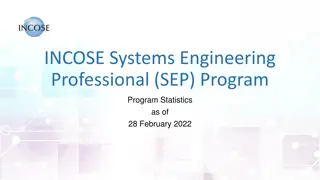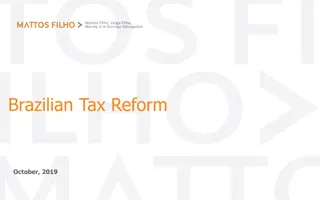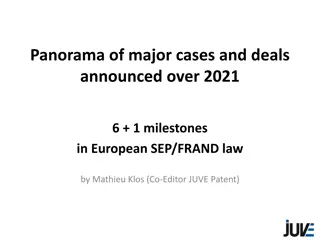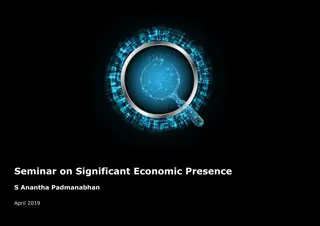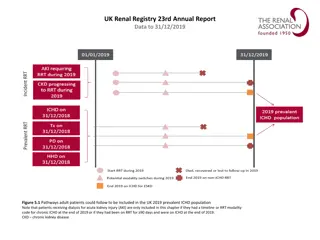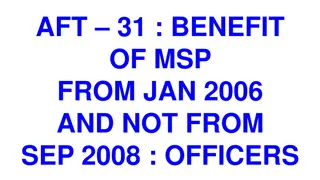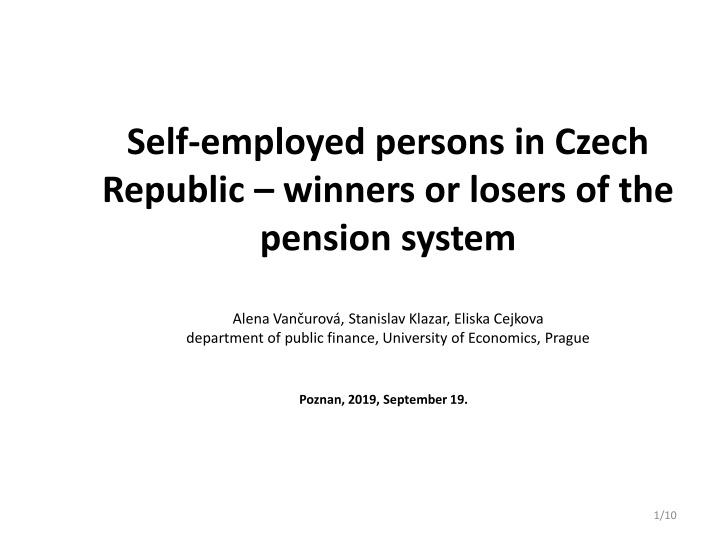
Research on Pension System for Self-Employed in Czech Republic
Explore the impact of the Czech pension system on self-employed individuals, focusing on future benefits, replacement rates, and system efficiency compared to workers. Gain insights into the challenges faced by self-employed persons regarding pension coverage.
Download Presentation

Please find below an Image/Link to download the presentation.
The content on the website is provided AS IS for your information and personal use only. It may not be sold, licensed, or shared on other websites without obtaining consent from the author. If you encounter any issues during the download, it is possible that the publisher has removed the file from their server.
You are allowed to download the files provided on this website for personal or commercial use, subject to the condition that they are used lawfully. All files are the property of their respective owners.
The content on the website is provided AS IS for your information and personal use only. It may not be sold, licensed, or shared on other websites without obtaining consent from the author.
E N D
Presentation Transcript
Self-employed persons in Czech Republic winners or losers of the pension system Alena Van urov , Stanislav Klazar, Eliska Cejkova department of public finance, University of Economics, Prague Poznan, 2019, September 19. 1/10
Intro Motivation of research Data The topical issue within the pension system in the Czech Republic is the level of coverage of self-employed persons who constantly report their income near the level of minimal basis during their WHOLE lifetime. Why now (2017 )? Time has come - the first wave of this kind of participant in the pension system (1st pillar) are ready to ask for their minimal pensions disillusion. disappointment resulting from the discovery that although their relative indicators are good, the real pension are not satisfying at all, so something is not as good as one believed it to be. Politicians begin to recognize this problem (MoLSA 2016 - Minister Marks appealed entrepreneurs: Please, pay more or !) Public letter see below. Methods Results Discussion References
POLICY LETTER from ministry to people MPSV 2016 - Pokud ivnostn ci odv d na d chodov poji t n minimum, do kaj se velmi mal ho d chodu, upozor uje MPSV, online http://www.mpsv.cz/files/clanky/23593/TZ_MPSV_upozornuje_OSVC_na_mozny_ni zky_duchod.pdf 3
Intro Motivation of research background Data Political situation - No time for long run-fundamental reform of Czech pension system. Why? Bad experience from Second pillar (2016). No time for fundamental reform so it is ONLY time for some outside of the system measures. One of them is to increase public literacy of lifetime saving, to increase ability to forecast the pension level to help them to make right decision. We believe that "scientia potentia est" (knowledge is power) and our humble believe is that the results will help to the participants to make a right decision. Methods Results Discussion References
Intro Aim of the paper Data We believe, that regardless of what demographic trends or developments in capital markets will be, early (though only approximate) knowledge of future pension benefits will help to participants make the right decisions. In this paper we would like to show the investment position of self-employed person within the Czech pension system. We based our analysis on comparison of workers (as a benchmark, most common participant) and self- employed persons (which have a specific position in the system from many point of view). We will estimate: 1. the nominal level of future pensions 2. replacement rates (RRs) 3. the lifetime efficiency of pension system for self employed person versus workers Methods Results Discussion References
Intro Methodology and modelling Data We describe the Czech pension system with the focus on the benefits from the system and the payments to the system We introduce simplified model for calculation of lifetime benefit and payment flows We focus on the pros and cons of the dataset (if time availability) Methods Results Discussion References
Intro Methodology and modelling II Data We estimate the standard measures of pension system efficiency replacement rates, lifetime (benefit/contribution) index) using the unique dataset of Assessment Base for Pension Insurance to shed the light on this problem. Methods Results Discussion References
How large can be this problem? Two aspects: how much are Czech people as a whole dependent on public pension system. See next graph AND number of underfinanced person self- employed person. See results later. 8
Is focus on only first pillar enough? Income sources of older people, 2014 or latest available year Public transfers Occupational transfers Capital Work Hungary 89 9 Austria 82 12 78 Czech Republic 20 Greece 77 19 France 77 5 Slovenia 75 21 Germany 69 15 Slovak Republic 71 28 70 Poland 29 Canada 35 25 Mexico 8 57 Korea 30 51 9 0% 10% 20% 30% 40% 50% 60% 70% 80% 90% 100%
SSCs as % of GDP, the most important source of public budgets 18 another reason why Czech people believe/count on public system 15.02 16 14 12.95 12 10 8 6 4 2 0 10
Mini summary: Our system allows them to pay only minimal contributions, but do not reveals clearly enough the negative consequences of this. Self employed persons live in illusion that are secured, but they are not. 11
Pension system in CR Formula, benefits from the system Payments into the system 13
Pension benefits in Czech Republic Individual monthly pension is sum of: Fix part (9% of AwWage) and earning-related part, which is calculated as N*0,015*( reduced almost lifetime updated monthly work-earnings), where: N is the number of service years Almost lifetime earnings means that only 1986+ period are taken into account Updated means that earnings are expressed in value of present year Reduced means that the progressive formula is applied. 14
Pension formula - How are we different? Pure insurance pension in Poland? Czech Republic Poland Net and gross replacement rates as a function of individual earnings, proportion of average earnings Net and gross replacement rates as a function of individual earnings, proportion of average earnings, Pensiont at Glance 15 2015
The devil is hidden in detail work related earnings Work-earning is base for the payments, as mentioned before. for employee it is SIMPLY gross wage with some minor exemption. for self-employed person it is something strange Strange ? There are two modifications applied for self-employed person. fundamental reduction of payment base The payment base for self-employed person is half of their economic profit. These 50 % is an estimate of the self-employed person wage so called income from labour. The rest of the profit is the capital income, which is not usually subject of pension insurance. Simply to say Profit = wage PLUS capital income minimal payment base 16
Pension payments to the system - rates There is rather complicated system of different linear payment rates based historically on Bismarck pension system with divided rates, 28 % for self-employed person and total 28 % for employee system (6.5 % plus 21.5 % covered by employee and employers in 2018). For our analysis it is important to discuss the economic incidence of pension payments. The question is whether the part paid by employer by the law (21.5 %) is also economically born by employer, OR BY EMPLOYEE? For a discussion see Gruber 1995, Klazar, Slint kov 2009, Saez, Slemrod 17
Intro Model: Data Assumptions for our simplified model are as follows. The persons apply for the pension in 2018. Our data covers the year 2017 as a starting point for our analysis. The number of the service years was chosen as 45 years There are no excluded days (It has only minimal effect on our results) The real income is the same for the whole last 26 years - according to the data from Pensions at glance (2015, section Gross replacement rate for average earners with different wage growth), the Czech pension benefits are highly immune to the changes of the income during the working career. According to the Holub (2008) the contribution to the system is paid only circa 80 % of service years (we chose 35 years of contributions). We believe this assumption and minor simplifications are still defensible. Methods Results Discussion References
Intro Dataset and modelling of lifetime individual position We were granted by the unique access to the dataset of Assessment Base for Pension Insurance (MoLSA dataset) Data Methods MoLSA dataset covers the whole population of persons who are subjects of pension system (1st pillar, PAYG financing), roughly 4.6 million of economics subjects, employee, self-employed persons and persons with the mix of these incomes. Results There is no other comparable dataset to this one. From the statistical point of view, it covers not just a sample, but the whole population, so the results from the statistical analysis are not just estimates, but the real measures describing the whole population. The information concerning earnings are directly the same as are used for the calculating of the both contribution to the system and the benefits from the system. Discussion References
The next section compares the main results for both groups of the insured person and derives some recommendations for the public policy. 20
Intro Results overview of profits and wages statistics Data Methods Results Discussion References 22
Intro Summary results for self- employed person Data Methods Base // profit (minimum) Absolute (relative) frequency Monthly pension benefit gross lifetime payments lifetime benefits benefit/paymen t ration replacement rate Results 0,61 (1,21)X 266 934 7 831 (333 Euro) 75 420 // 739 116 1 373 580 1.86 (48 %) Discussion 150 840 Note: Payment rate is 28 % for the whole payment period (35 years). We suppose that the pensioner will be receiving the pension for 15 years. Gross RR = pension/profit References Gross RRX= pension/(0.5profit) X benefits/only work-related earnings
Intro Summary results for employee and distributions of income - table Data Methods Results Discussion References 24
Revenues Cost actual Cost blanked (flat tax expenditures) Actual living standards Reported living standars Benefis BEN/actulal BEN/reported 100 100 0,5 50 Another Evil in the system 0,8 80 50 20 12 0,6 0,24 0,6 25
Intro Conclusions Data The analysis revealed, that the 50 % of self-employed persons face the gross replacement ration (RR) equals to 61 %, (or 121 % if the reduction of the profit by 50 % is taken into account - assessment base is a 50 % of profit), in comparison with the employees, who face the gross RR equals to 50 % for average wages and 56 % for median wages. Completely different picture is revealed if we focus on the nominal measure (nominal pension for month or nominal pension on the lifetime basis). The nominal pensions for self-employed persons reporting the minimal base are CZK 7 831 with comparison of CZK 12 471 (11 702) for average (median) wages. Methods Results Discussion References 26
Learning process To know the nominal benefits To compare them with payments (system is relatively good for self-employed persons, no reason for opt-out, they should stay there) To compare them with living standard faced during the working/active period And as a result To help to make better decision (to save more) 27
Short summary The Czech self-employed persons live in the dangerous illusion. They are winners (relative benefits are huge), but still not enough to sustain the previous living standards. And it must be admitted that a very problematic role plays also Czech legislation/setting of flat tax expenditure and setting of earning base for pension payments to the system. 28
Intro Conclusions cont. Data Due to high level of progressivity of pension system in the Czech Republic the poorer group reaches the better relative measures (gross and net RRs). Due to assumption, that capital income is not limited to the serviced period and is accessible also in the retirement period, the assessment base is reduced by law by 50 %. This reduction is the second reason of low level of nominal benefits for self-employed persons. We believe that academic and political discussion of the reduction level of assessment base will initiate the changes of this level. We also believe that easy accessible and correct information concerning the individual estimated future benefits (as for example in Sweden, Pensionsmyndigheten (2016)) can motivate the persons to increase the level of contribution (not only) to the public pension schemes. Methods Results Discussion References 29

